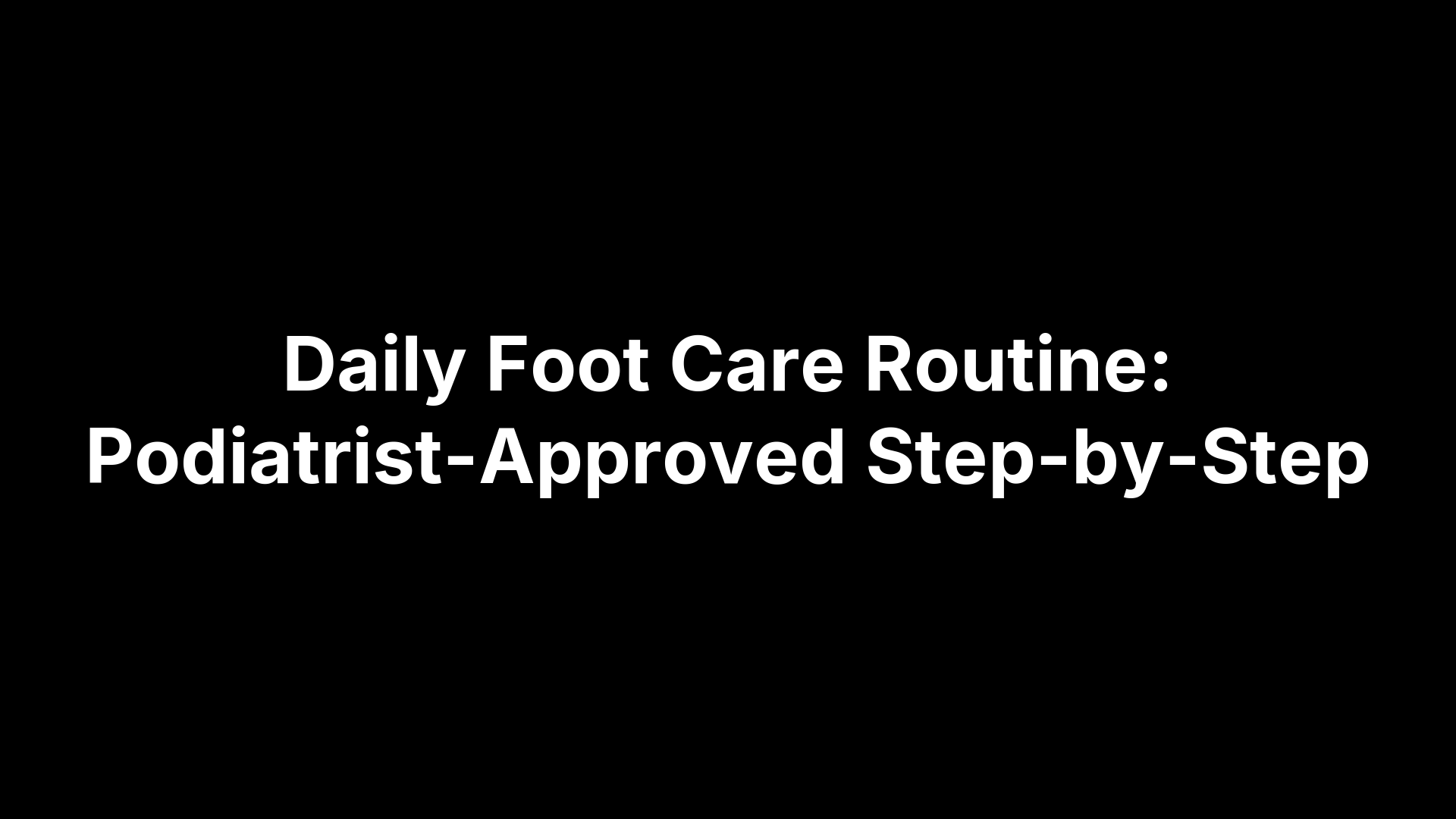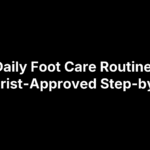Your feet carry you everywhere you need to go. But as you age, maintaining healthy feet becomes increasingly difficult. Thick toenails resist clipping. Dry skin cracks and itches. Poor circulation slows healing. And if you live with diabetes or nerve damage, you might not notice problems until they become severe.
These changes aren’t merely uncomfortable. They lead to infections, painful wounds, falls, and complications that threaten your mobility and independence. But here’s the encouraging news: consistent daily care prevents most foot problems before they escalate.
This guide walks you through six essential habits for senior foot care. You’ll discover how to inspect your feet properly, maintain hygiene, trim nails without injury, and select shoes that support and protect. We’ll identify red flags requiring immediate medical attention and explain which podiatry services Medicare covers. Whether you’re caring for your own feet or helping an aging parent or loved one, these practical strategies will preserve foot health and keep you moving confidently through your daily life.
1. Podiatry care at Achilles Foot and Ankle Center
Professional podiatry care forms the foundation of effective foot care for seniors. Achilles Foot and Ankle Center provides specialized services across thirteen locations in Central Virginia, offering comprehensive foot and ankle treatment from routine maintenance to advanced surgical procedures. The practice operates the region’s only Foot and Ankle Ambulatory Surgery Center, combining concierge-style attention with acceptance of all major insurance plans including Medicare and Medicaid.
Why this matters
Your feet face unique challenges as you age that require specialized medical expertise. Achilles Foot and Ankle Center’s team addresses conditions ranging from diabetic foot complications and chronic wound management to nerve pain, heel discomfort, and structural deformities. The practice employs advanced technology including digital imaging, ultrasound guidance, and fluoroscopy-guided injections to diagnose problems accurately and treat them effectively. You gain access to both conservative therapies (custom orthotics, physical therapy, bracing) and surgical solutions when necessary, all coordinated by board-certified specialists who understand aging foot anatomy.
How to do it
Schedule an appointment through the Healow Patient Portal or call directly for same-day availability when urgent issues arise. The practice serves multiple convenient locations throughout the Richmond metropolitan area, reducing travel burden for patients with mobility limitations.
Tips for seniors and caregivers
Establish a regular podiatry schedule rather than waiting for problems to worsen. Bring a complete list of current medications and health conditions to your first visit, particularly if you manage diabetes or circulation disorders. Utilize the patient portal to track appointments, review care instructions, and communicate with your provider between visits.
Regular professional foot examinations catch problems before they compromise your mobility and independence.
2. Daily foot checks and gentle cleaning
Daily inspection and proper hygiene prevent minor irritations from becoming serious health threats. You should examine your feet every morning or evening as part of your routine, checking both the tops and bottoms for any changes. Regular cleaning removes bacteria and prevents infections while careful observation catches problems when they’re still simple to treat.
Why this matters
Your feet lose sensitivity as you age, particularly if you have diabetes or peripheral neuropathy. This numbness means you might not feel a small cut, blister, or developing sore until infection sets in. Early detection through daily checks allows you to address issues immediately, preventing complications that could lead to hospitalization or worse. The American Geriatrics Society reports that one-third of people older than 65 experience foot problems, many of which start as overlooked minor injuries.
Changes in circulation slow your body’s natural healing response. A problem that would resolve quickly in younger feet can persist and worsen in aging skin. Daily vigilance becomes your first line of defense against infections, ulcers, and other complications that threaten your mobility.
How to do it
Start by washing your feet daily with warm (not hot) water and mild soap. Test water temperature with your wrist or elbow rather than your foot, as reduced sensation can prevent you from noticing water that’s too hot. Gently clean between each toe, then pat your feet completely dry with a soft towel, paying special attention to the spaces between your toes where moisture breeds fungal infections.
Use a long-handled mirror or ask someone to help you inspect the bottoms of your feet. Look for cuts, blisters, red spots, swelling, bruises, or any areas where the skin appears broken down. Check between your toes for cracking or peeling skin. Note any new calluses, corns, or changes in toenail color or thickness.
Daily foot inspection catches problems before they compromise your health and independence.
Tips for seniors and caregivers
Set a consistent time each day for foot care for seniors, linking it to another daily habit like morning medications or evening television. Keep inspection tools (mirror, good lighting, magnifying glass if needed) in an easily accessible location. If limited flexibility makes self-examination difficult, schedule weekly checks with a family member or caregiver who can thoroughly inspect your feet and document any concerns.
Apply moisturizing lotion after washing to prevent dry, cracked skin, but avoid applying it between your toes where excess moisture encourages fungal growth. If you discover anything unusual during your inspection, photograph it with your phone to track changes and show your podiatrist if the problem persists.
3. Safe nail and skin care routine
Proper nail trimming and skin maintenance prevent painful complications that limit your mobility. Toenails thicken with age, becoming difficult to cut safely with standard clippers. Calluses and dry skin crack under pressure, creating entry points for infection. This section shows you how to care for your nails and skin without causing injury, whether you handle the tasks yourself or rely on professional help.
Why this matters
Your aging feet develop thicker, more brittle nails that resist conventional cutting methods and may harbor fungal infections beneath the surface. Improper trimming leads to ingrown toenails that cause severe pain, swelling, and infection requiring medical intervention. People with diabetes face particular risk, as minor nail injuries can progress to serious wounds.
Skin changes compound these challenges. The protective fat padding in your feet thins over time while your skin produces less natural moisture, resulting in dry, cracked surfaces vulnerable to bacterial invasion. Calluses form from pressure and friction, but aggressive removal attempts often damage healthy tissue underneath, creating wounds that heal slowly due to reduced circulation.
How to do it
Trim your toenails straight across using proper nail clippers (not scissors), cutting them no shorter than the tip of your toe. Smooth any sharp edges with an emery board to prevent them from catching on socks or cutting adjacent toes. Schedule this task after bathing when nails soften slightly, making them easier to cut safely.
Apply fragrance-free moisturizing cream or lotion to your feet daily after cleaning, but skip the areas between your toes. If your nails appear thick, yellowed, or difficult to trim, visit a podiatrist rather than attempting aggressive cutting yourself. Professional podiatrists possess specialized tools and training for safe nail care when standard methods become inadequate.
Professional nail trimming prevents injuries that could compromise your foot health and independence.
Tips for seniors and caregivers
Never use sharp instruments or razors to remove calluses yourself, as this approach frequently causes cuts requiring medical treatment. If you cannot reach your feet comfortably or see clearly enough for safe trimming, arrange regular appointments with a podiatrist rather than risking injury at a nail salon where technicians lack medical training for diabetic foot care for seniors or compromised circulation.
Watch for warning signs that require professional attention: nails that curve sharply into the skin, persistent redness around nail edges, or calluses that develop dark spots or drainage.
4. Supportive shoes socks and home safety
Your footwear choices and home environment directly impact your risk of falls, injuries, and chronic foot problems. Proper shoes provide stability and cushioning while appropriate socks manage moisture without constricting circulation. Creating a safe walking environment indoors completes your protective strategy, reducing hazards that could lead to serious injury.
Why this matters
Falls represent a leading cause of injury among older adults, often starting with poorly fitted shoes or slippery home surfaces. Your feet require closed-toe shoes with non-slip soles that offer arch support and cushioning, preventing the blisters, cuts, and balance problems that arise from inadequate footwear. Walking barefoot or wearing slippers without grip exposes you to injury both indoors and outdoors.
Changes in foot structure as you age mean shoes that fit correctly last year may now cause problems. Feet flatten and lengthen over time, while conditions like bunions or hammertoes alter your foot shape. Wearing shoes that rub or slide creates blisters that can develop into serious sores, particularly if you have diabetes or reduced circulation.
How to do it
Choose professionally fitted shoes with adequate toe room, strong arch support, and cushioned insoles. Avoid high heels, pointed toes, or shoes with slick bottoms. Change your clean, dry socks daily, selecting materials that wick moisture away from your skin. Padded socks add extra protection if your podiatrist recommends them.
Secure loose rugs with non-slip pads and improve lighting in hallways, stairs, and bathrooms. Remove clutter from walking paths and install grab bars near toilets and bathtubs.
Proper footwear and a safe home environment prevent injuries that could compromise your mobility.
Tips for seniors and caregivers
Ask your doctor about prescription orthotics, which Medicare may partially cover if you have diabetes or neuropathy. Wear shoes indoors as much as possible rather than going barefoot, protecting your feet from unseen objects. Consider consulting with an occupational therapist who can assess your home for additional safety modifications specific to your foot care for seniors needs.
5. Red flags you should never ignore
Certain symptoms demand immediate medical attention rather than home treatment. Recognizing these warning signs allows you to seek care before minor problems escalate into serious complications. This section identifies the specific changes in your feet that require prompt evaluation by a podiatrist, particularly when they signal infection, circulation problems, or diabetic complications.
Why this matters
Your feet communicate important health information through visible changes and symptoms. Delayed treatment of serious foot conditions leads to infections that spread into bone, wounds that won’t heal, and complications requiring hospitalization or amputation. People with diabetes face heightened risk because reduced sensation masks pain that would otherwise alert you to urgent problems. Early intervention prevents these outcomes by addressing issues while they remain manageable.
How to do it
Contact your podiatrist immediately if you notice persistent redness, warmth, or swelling in any part of your foot. Seek care for open sores, cuts that won’t heal, or drainage from any wound regardless of size. Other urgent signs include sudden numbness or tingling, discolored toenails with foul odor, fever accompanying foot pain, or inability to bear weight on your foot.
Immediate medical attention for foot warning signs prevents complications that could threaten your mobility and health.
Tips for seniors and caregivers
Document concerning changes with dated photographs to show your provider how quickly symptoms progress. Never attempt to treat infected wounds or deep sores yourself with over-the-counter products. If you have diabetes and notice any break in your skin, schedule an appointment within 24 hours even if the area seems minor, as foot care for seniors with this condition requires specialized medical oversight.
6. Medicare and coverage for senior foot care
Understanding your Medicare benefits helps you access necessary podiatry services without unexpected costs. Medicare Part B covers podiatrist care when you need medically necessary treatment for foot injuries, diseases, or conditions like diabetes-related nerve damage that increases your risk of limb loss. However, routine foot care remains excluded unless specific qualifying conditions apply, making it essential to know which services your plan covers before scheduling appointments.
Why this matters
Medical foot care for seniors with diabetes, circulation problems, or structural deformities often requires ongoing professional attention that accumulates significant expense over time. Knowing your coverage limits prevents surprise bills while ensuring you receive the treatment your feet need. Many seniors skip necessary podiatry visits because they assume Medicare won’t cover them, allowing treatable problems to progress into serious complications requiring hospitalization.
How to do it
Contact Medicare directly or review your Summary of Benefits to confirm which podiatry services qualify for coverage under your plan. Your doctor must document medical necessity for treatments like nail trimming, callus removal, or prescription orthotics. Part B typically covers 80 percent of the Medicare-approved amount after you meet your annual deductible, leaving you responsible for the remaining 20 percent plus any additional costs your provider charges above the approved rate.
Understanding Medicare coverage ensures you receive necessary foot care without financial surprise.
Tips for seniors and caregivers
Ask your podiatrist’s office to verify coverage before each appointment, as qualifying conditions determine whether Medicare will pay for specific services. Keep detailed records of your diabetes management, circulation issues, or other conditions that support medical necessity. Consider Medicare Supplement Insurance (Medigap) to help cover the 20 percent coinsurance and other out-of-pocket expenses related to your foot care for seniors needs.
Key takeaways
Your feet deserve consistent attention throughout your senior years. Daily inspection and gentle cleaning catch problems before they escalate, while proper nail trimming and moisturizing prevent painful complications that limit mobility. Wearing supportive shoes with non-slip soles reduces your fall risk and protects vulnerable foot structures from injury.
Professional podiatry care addresses issues that home maintenance cannot handle safely. Watch for red flags like persistent redness, non-healing wounds, or sudden numbness that require immediate medical attention. Understanding your Medicare coverage ensures you receive necessary treatments without financial surprise, particularly if you manage diabetes or circulation disorders.
The six habits outlined in this guide form a complete strategy for maintaining healthy, functional feet as you age. Schedule a consultation at Achilles Foot and Ankle Center to establish a personalized foot care for seniors plan that addresses your specific conditions and concerns. Our team provides comprehensive podiatry services across thirteen convenient Central Virginia locations, accepting all major insurance plans including Medicare and Medicaid.






